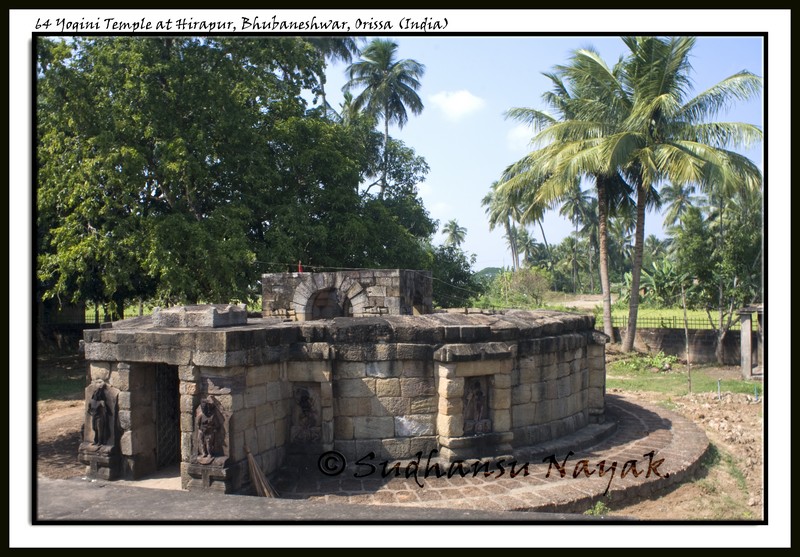
There are nine oblong niches on the outer perimeter wall of the temple as is eveident from the above picture. There are 9 Katyayanis in these niches in various forms.
Katyayani-1: one of the Katyayanis on the outer perimeter wall
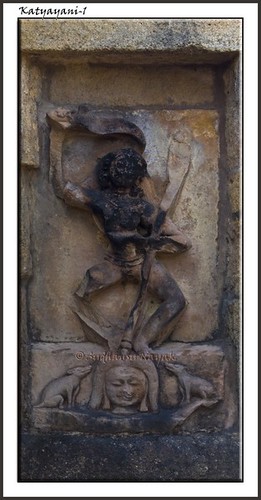
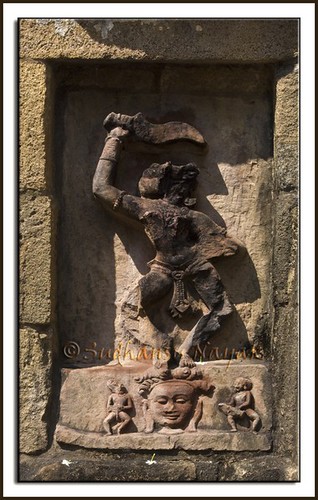
Similarly there are 7 more such katyayanis on the outer perimeter wall.
If one observes very carefully, at the base of these statues, one would see a severed head, sometimes a jackal or a dog or a pig-normally interpreted to be the animals found near dead bodies or carcasses, and almost all the Katyayanis hold different types of blades as if raised to dismember or behead. The significance of this is beyond my comprehension as I write this document but I some how have a hunch that they had been installed to act as directional notional security points of what was intended to take place inside the temple.
As one apporaches the entrance facing east, it is evident that the entrance is a very narrow entrance which opens up inside into a circular structure.On both sides of the entrance, one finds the Dwarapalas and on the inner walls of the entrance, there are statues of Kala and Mahakala.


I am not sure if there is any connection to the following or whether the identification of the statues as Kala and Mahakala is correct.
In this myth, Brahmâ and Vishnu, the other two members of the Hindu trinity, were disputing with each other for the status of supreme God. They appealed to the testimony of the four Vedas, which unanimously proclaimed Rudra-Shiva as the Ultimate Truth of the universe. But the disputants were unable to accept that Rudra, endowed with so many revolting symbols of impurity and degradation, could be identical with the Absolute Reality of Brahman, the formless metaphysical Reality behind all phenomena. It was at this juncture that Shiva appeared as a fiery pillar of light (jyotir linga) uniting the netherworlds and the heavens. The fifth head of Brahmâ taunted Shiva who, overflowing with anger, created a blazing Bhairava in human form. Addressing this Kâla Bhairava as "Lord of Time-Death" (Kâla), for he shone like the god of Death, Shiva ordered him to chastise Brahmâ, promising him in return eternal suzerainty over his sacred city of Kâshî (Benares). Seeing Bhairava rip off Brahmâ's guilty head, the terrified Vishnu eulogized Shiva and devotedly recited his sacred hymns, followed in this by the now repentant Brahmâ. They thus acknowledged the supreme reality of Shiva. The severed head immediately stuck to Bhairava’s hand, where it remained as the skull destined to serve as his insatiable begging bowl. Enjoining him to honor Vishnu and Brahmâ, Shiva then directed Bhairava to roam the world in this beggarly condition to atone for the sin of Brahmanicide. "Show to the world the rite of expiation for removing the sin of Brahmanicide. Beg for alms by resorting to the penitential rite of the skull (kapâla-vrata)." Creating a maiden renowned as ‘Brahmanicide’ (brahma-hatyâ), Shiva instructed her to relentlessly follow Bhairava everywhere until he reached the holy city of Kâshî to which she would have no access. Finally absolved, the criminal god was immediately promoted to policeman-magistrate (Kotwal) entrusted with barring the entry of other evil-doers into this city of death and final liberation. There are three basic iconographic representations of Bhairava which derive from this myth.
a) As Brahma-shiras-chedaka, he grasps by its hair the severed head whose dripping blood is greedily lapped up by his dog, and thus becomes a Kapâlin or ‘skull-bearer’.
b) As Kankâla-mûrti, he is shown spearing a man or already bearing the latter’s corpse (or skeleton) on his shoulder. This illustrates that episode in Bhairava’s wanderings when he slays Vivaksena, the Brahman guardian who tries to bar his access to Vishnu’s abode. In both cases, he is either naked or wearing a tiger or elephant skin, a garland of human skulls, snakes around his neck and arms, and is grotesque with dark-skin and monstrous fangs.
c) Third, as the milder Bhikshâtana-mûrti, he roams begging for alms from the wives of the Seven (Vedic) Sages in the Daru forest. In this episode, the women are so seduced by his naked beauty that they abandon all shame.
Even the iconography also maps few symbols like the begging bowls, dog like creature sitting at the bottom, snakes which are normally associated with Lord Shiva, can these statues be corressponding to "Brahma-shiras-chedaka" and "Kankâla-mûrti"? And if two forms are depicted-that of "Brahma-shiras-chedaka" and "Kankâla-mûrti", why is the third form-"Bhikshâtana-mûrti" not depicted anywhere?
Also, while doing the research for this article on the structure, I had come across an interesting interpretation. Mr Prithwiraj Misra, in his article, "Shiva and His Consorts-The Yoginis of Hirapur" mentions that the narrow entrance to the peeth is not dissimilar to the passage of the yoni, constricted at the opening, but widening into an open circle (a womb) that embraces urdhvalinga Shiva Bhairava at the centre. A perusal of some of the texts written by experts leaves one surprised by the total absence of any such observation of the structure in terms of yoni-linga union, even though the shape quite naturally suggests this. He also differs from Dr Vidya Dehejia on this point. He says, regarding the shape of the shrine, Vidya Dehijia’s contention that the circularity has something to do with Buddhist (stupa) symbolism, is way off the mark. See her preface to Yogini Cult and Temples : A Tantric Tradition. Even Thomas Donaldson in his monumental Kamadeva’s Pleasure Garden: Orissa seems to have ignored this aspect of the yogini shrines altogether. I somehow get inclined to go with Mr Mishra's interpretation on the structure. After having perused through multiple documents, iconography and pictures about Budhism, I can say that a hypaethral temple with idyphallic (urdhvalinga) Shiva statues has nothing to do with Buddhist symbolism. With Jainism too, taking the digambara beliefs into consideration, it is still a long shot.
Coming back to the temple structure- directly infront, one would see the square structure in the middle of the circular structure. One would immediately see three statues: One of Mahamaya: the presiding deity of the temple bang in the centre, placed on an oblong niche of the inner wall of the temple perimeter. There are two niches on the east facades of the pillars of the central cuboidal structure. This holds the statue of Ajaika Pada Bhairava to your left as you enter and the statue of Swacchanda Bhairava on the right.


With a look at the south facdes of the pillars to the central cuboidal structure, one comes across two more statues of Swacchanda Bhairava.

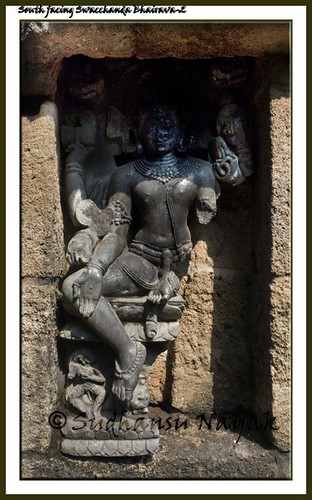
All the Swacchanda Bhiaravas are ten-armed seated figures, each placed on a lotus seat, with a recumbent male body below accompanied by a small dancing female who is brandishing a knife in one hand and holding a skull cup in the other. All tour Bhairavas are depicted with erect phalluses (idyphallic/urdhva linga), standard for Shaiva images in Orissa. As per Probing the mysteries of the Hirapur Yoginis, Gadon, Elinor W., When the temple was rediscovered in 1953, a free-standing image of Shiva stood within the mandapa but was stolen shortly thereafter.
Currently, the research on the Bhiaravas is underway. I shall update this section in more detail shortly.
Now as one turns towards the inner perimeter, as per the nomenclature followed in the temple (yes all the statues are numbered), one has to start from the left side of the entrance as one enters. All yogini statues are exquisitely carved from black chlorite, a material that has preserved all details of jewelry and ornamentation, forming a striking contrast to the smooth areas that denote naked skin. Their gleaming, polished beauty seems pristine despite some smashed faces and broken limbs, the depredations of vandals over the centuries. Carved in the classical medieval Kalinga style (ninth to thirteenth century), they represent the Indian ideal of feminine beauty, with full breasts, narrow waists, and ample hips, their bodies gracefully posed to enhance their sensuality.Each Yogini stands in her own niche. All stand side by side on their vahanas, the celestial mounts depicted on their pedestals. The vahanas include animals such as the ass, alligator, bull, boar, buffalo, camel, crow, cock, crab, deer, elephant, scorpion, tortoise, and snake; vegetable symbols such as the lotus and other kinds of flowers; and inanimate objects such as a table, vase, or wheel, as well as human heads and corpses. All these symbols must have originally been keys to the identification of the Yoginis by their votaries. The esoteric meaning of these symbols of their powers is now apparently lost in most cases. However, it may still survive in oral tradition.
Most Yogini images at Hirapur are two armed, although others are four armed. However, one image-Mahamaya, enshrined in niche 31, directly opposite the entrance and larger than the others, is ten armed. As the presiding deity, she stands on a full-blown lotus. Iconographically this image conforms to the description of Mahamaya in the fourteenth-century Kalika Purana. Kali was identified with the maya principle, the power of cosmic delusion emanating from the god Vishnu, and personified as Mahamaya as far back as the sixth-century Devi Mahatmya (Hymns of Praise to the Great Goddess) and is still in worship by the locals as their gramadevi under that name.
Now lets look at the images of the Yoginis in detail:
1/2: Chandika on corpse/ Tara on Corpse
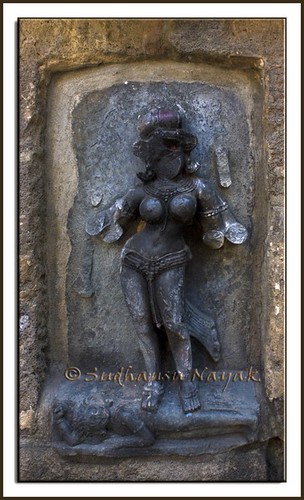

3/4: Narmada on Gaja (Elephant)/ Yamuna on kurma (turtle)
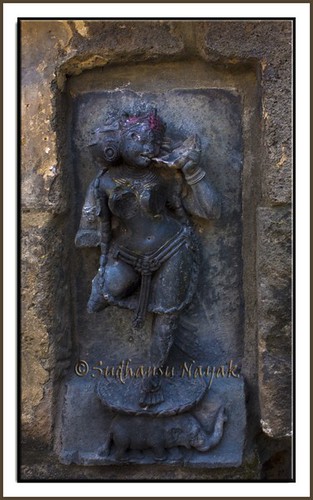
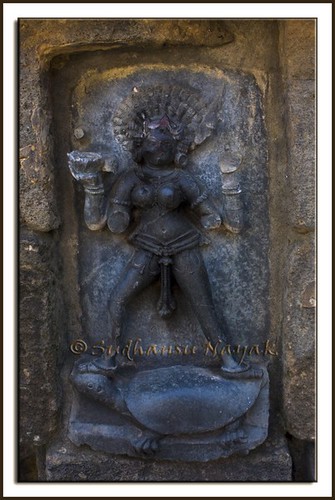
5/6: Mananda on padma (Lotus)/ Baruni on water


7/8:Gauri on Iguana/ Indrani on Airavata (Elephant)

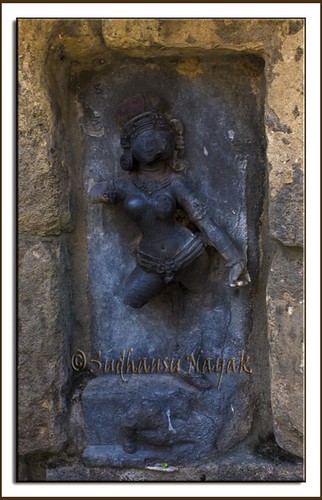
9/10: Varahi on varaha (Boar)/ Padmavati on Sarpa (Snake)


11/12: Oshtagriva on Camel/ Vaishnavi on Owl

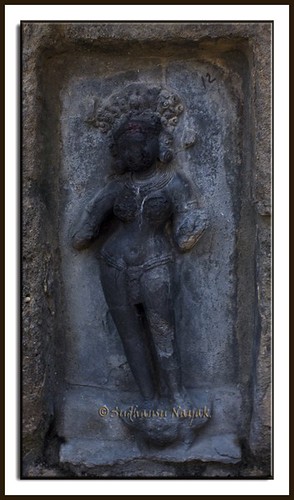
13/ 14: Panchavarahi on Varaha (Boar)/ Badyarupi on Dhol (drums)

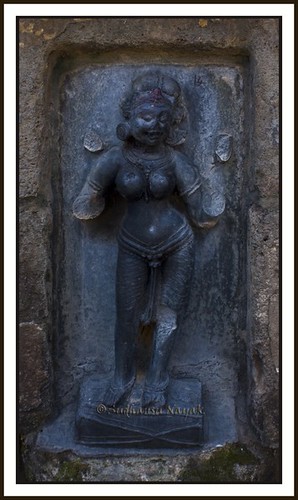
15/ 16: Charchika on Asura (Demon)/ Betali on Fish


17/ 18: Chinna Mastaka on chinna-mastak(severed head)/ Vindhyavasini on hills


19/ 20: Jalakamini on frog/ Ghatavaraha on Lion
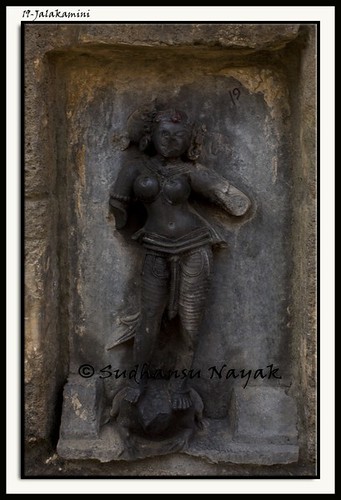

21/ 22: Kakarali on Dog / Saraswati on Lotus with Snake entangled
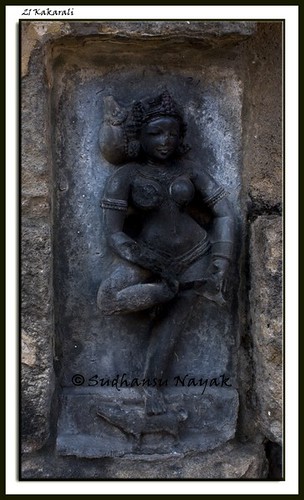

23/ 24:Virupa on water/ Kuberi on Puspaka (lotus)


25/ 26: Bhallooki (Form of Bear)on Tree branch full of flowers/Narasinghi(Female energy form of Narasingha) on flowers on ground


27/ 28: Biraja on Lotus/ Bikatanayana (means Ferocious Eyes) on (not known)
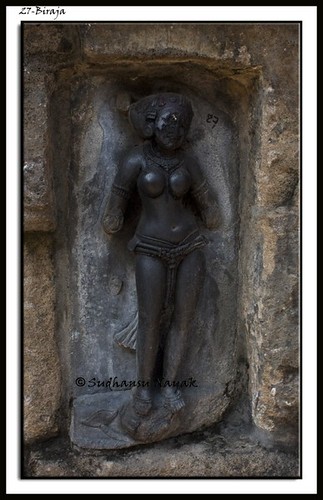

29/ 30: MahaLakshmi on Lotus/ Kaumari on Peacock
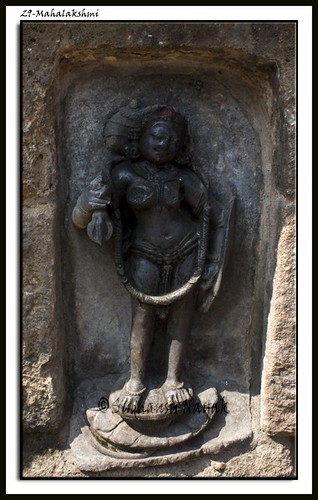
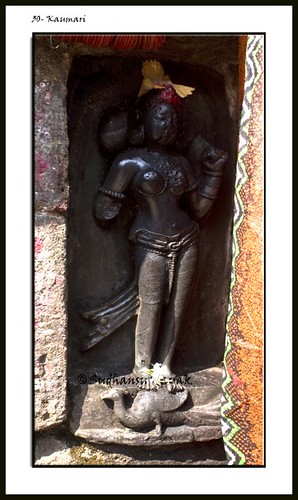
31/32: Mahamaya on Full Lotus/ Rati on archer (probably denoting Kamadeva's bow and arrow)
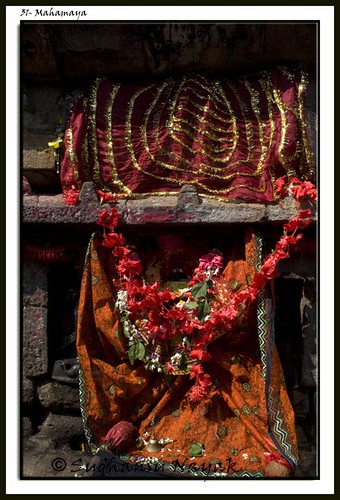
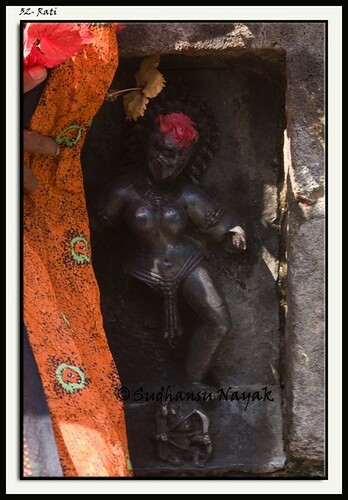
33/ 34: Karkari on Crab/Sarpasa on (not known)


35/ 36: Jasa on stool/ Aghora on Goat


37/ 38: Rudrakali on Crow/Vinayaki on Donkey (This part is doubtful since Vinayaka, other wise called Lord Ganesha, rides the Mouse)
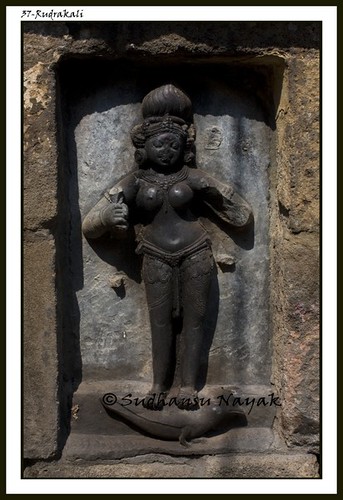
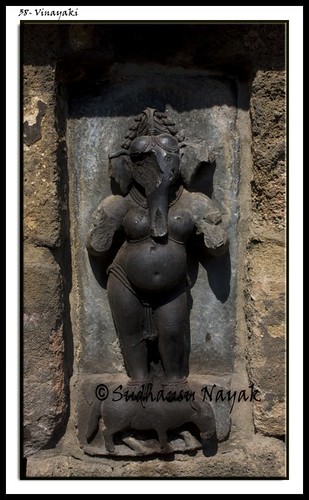
39/ 40: Vindhyavaliki on mouse/ Virakumari on scorpion
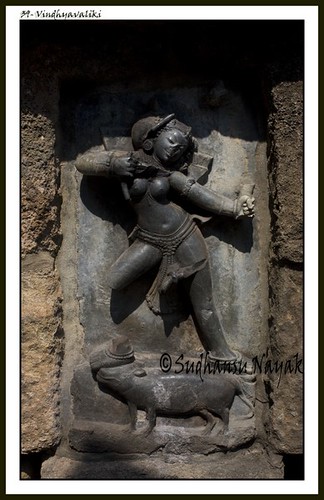

41/ 42: Maheshwari on Bull/ Ambika on Mongoose (Why are there two ribs' sets on the back of the mongoose is not clear yet)
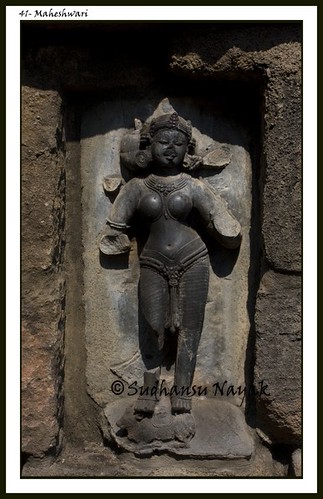

43/ 44:Kamakshi on hen/ Ghatobari on Lion
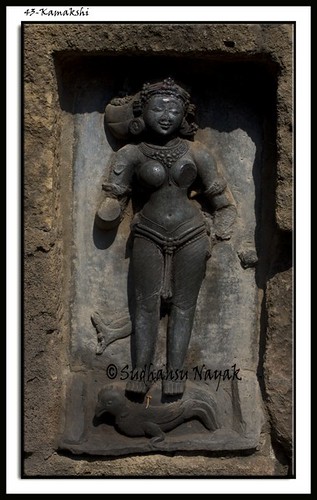

45/ 46: Stutee on Sandal Pot/Kali on shiva
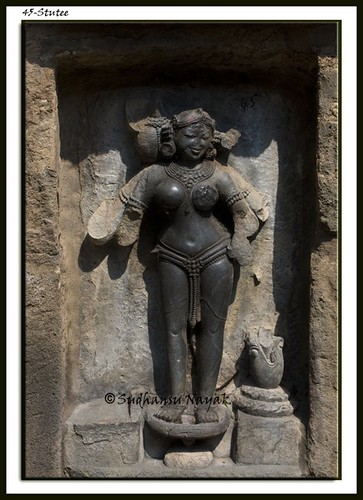
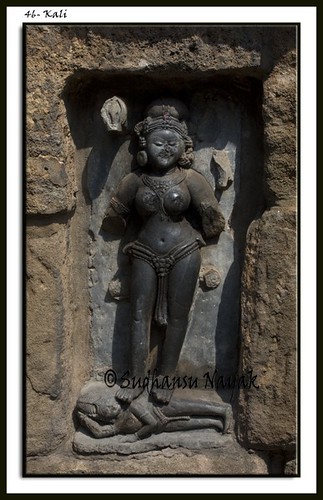
47/ 48: Uma on flowers/ Narayani on Kalash (Pot)
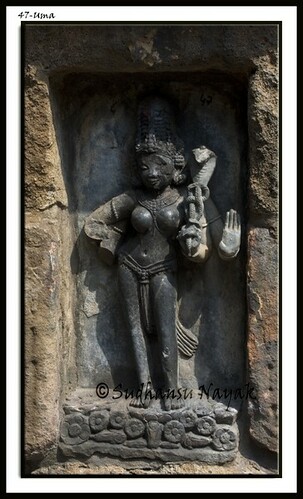

49/ 50: Samudri on Conch/ Brahmani on Book (probably Vedas)


51/ 52: Jwalamukhi on Cot/ Agnihotri on sheep
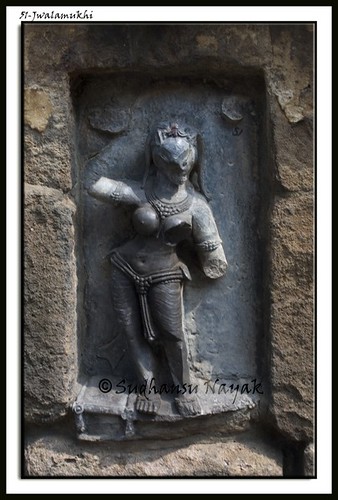
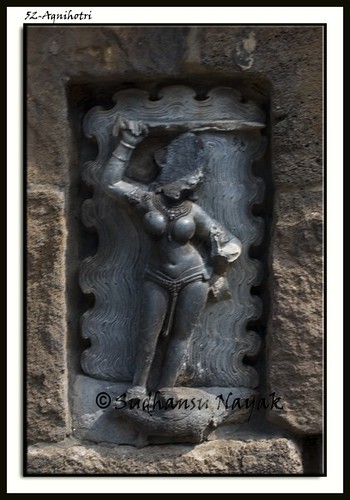
53/54: Aditi on Parrot/ Chandrakanti on stool
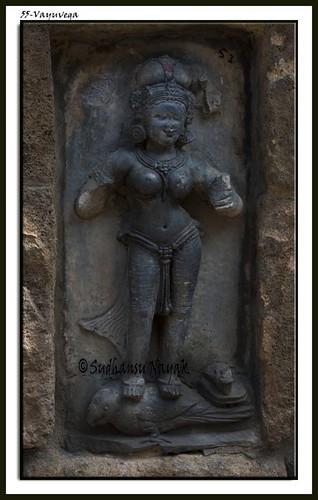

55/ 56: Vayuvega on Yak/ Chamunda on Musk

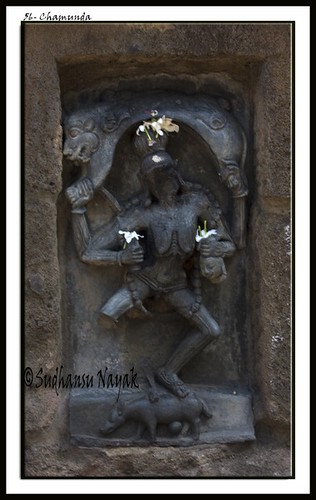
57/ 58: Maruti on Deer/ Ganga on Makara (Crocodile)
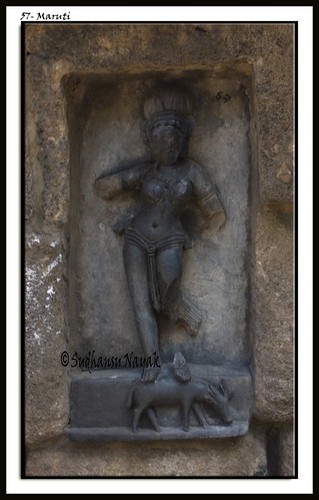

59/ 60: Dhumavati on Duck/ Gandhari on Donkey
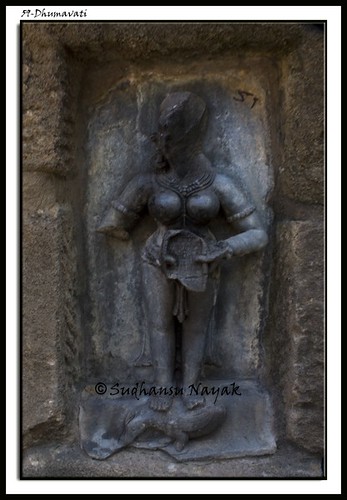
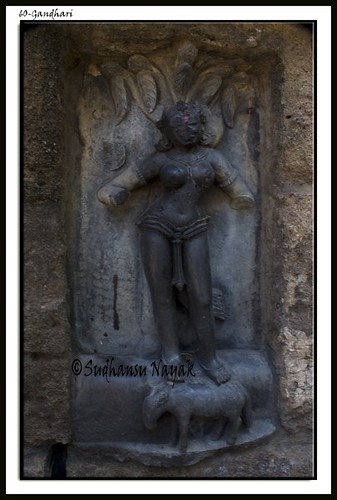
61/ 62: (empty)/ Ajita on Deer
Niche 61 is empty

63/ 64: Suryaputri on horse/ Vayuveena on Deer
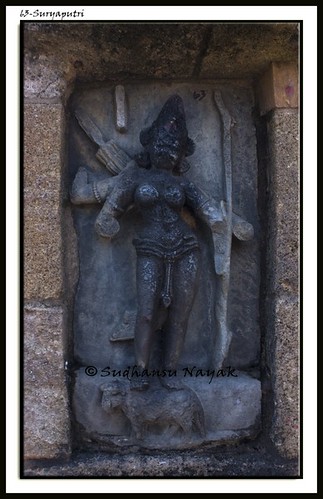

All the Ashtamatrikas (8 prime divine mothers) covered as 8-Indrani (Also Called Aindri), 9-Varahi, 12-Vaishnavi, 26-Narasinghi, 30-Kaumari, 41-Maheshwari, 56-Chamunda
With these details, I would like to conclude my series on 64-Yogini Temple at Hirapur, Bhubaneshwar, Orissa. I would update the blog as and when more points from the research crop up. Hope you enjoyed the jouney as much as I did while making it.
Just in case, you want to refer to some more articles on the topic:
1. In Odia: An Article by Pt Antarjyami Mishra http://www.orissasambad.com/news_article.php?id=7333

Hi sudanshu,
ReplyDeleteWonderful pictures you have here. I'd like to request for permission to use the originals as I write and research heavily on the topic and also deliver lectures/conferences. Please write to me at chitgo(at)airtelmail(dot)in and visit www.chitgopekar.com to learn more.
To clarify, I am using my son's google account to post the message. Many thanks.
ReplyDeleteDear Sudhansu, You've created a wonderful article here and I am grateful for your visual documentation of this important shrine.
ReplyDeleteI also appreciated your report on Mr. Mishra's theory about the temple shape. I agree with you that it has great potential.
Around the time you posted your article I created one about the Chaunsat Yogini temple. Perhaps these women again have something to say!
http://www.devata.org/2010/03/india%E2%80%99s-chaunsat-yogini-temple-and-the-women-of-angkor-wat/
With best regards,
Kent
Hari OM. Dear Sudhansu, thank you for these beautiful images. I am most inspired. Came upon your site in researching the 64 yoginis for a book I am writing about women and yoga. May I request permission to include the overview of the temple and some of the yogini images as illustrations in the book? You can see more about my work www.wombyoga.org and www.sitaram.org. My email is yoga@sitaram.org
ReplyDeleteWith great respect and love I send warm wishes for your well-being
Uma
Thanks for these information,most Hindus don't know them,
DeleteExcellent work, never before seen elsewhere. Congratulations.
ReplyDelete64 Yoginis ( feminine energy) can be seen in concurrence with 64 DNA codes........
ReplyDeleteModern science speaks about 20 codes currently activated out of these 64 DNA codes and perhaps these active codes corresponds more to 5 senses ........
This is excellent.
ReplyDeleteDear Sudhanshu,
ReplyDeleteAlthough I had searched the details on 64 Yogini Temple in Google after my first visit to the shrine in June 2013, I never came across such vivid details of this almost lost temple as yours. Apart from the serenity of the temple complex, I also liked Hirapur's surroundings. Would request you to add some pictures of it & its surrounding including the water bodies around.
Happy Blogging
TARANISEN PATTNAIK
tarani4u@gmail.com
thx u for providing all information at a single place
ReplyDeletethis is really great... but can you tell me.. whether it will be ok if i visit to this place from Puri.... we have our train at night... and i was thinking of checking out this place in the morning before leaving for Kolkata... can that be done?
ReplyDeleteThis comment has been removed by the author.
ReplyDeleteFabulous article and wonderful pictures.
ReplyDeleteBrilliant piece! Seems you have done quite a bit of research on the subject. Awesome
ReplyDeleteRgds
Vg
www.vgopalan.blogspot.in
I AM PLANNING TO CONSTRUCT A TEMPLE FOR 64 SHAKTI PEETAS / YOGINIS NEAR KOLAR GOLD FIELDS IN KARNATAKA, PLEASE CONTACT ME FOR FURTHER INFORMATION AND HELP IN TEMPLE WORK
ReplyDeleteDR. L. RAMAKRISHNA, 6303097347 / 9010621504 / dr.ramakrishnal@gmail.com